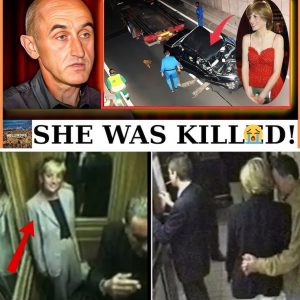THE 36-MINUTE BLACK HOLE

Princess Diana’s car crashed at 12:23 AM. Yet the first official ambulance record doesn’t appear until 12:59 AM. That’s a 36-minute gap in central Paris — a city wired with cameras and sirens.
What happened in those missing minutes? For some, it’s the single most haunting clue that Diana’s life was never meant to be saved.
The 36-Minute Black Hole: Unraveling the Mystery of Princess Diana’s Final Moments
On August 31, 1997, at 12:23 a.m., a black Mercedes S280 carrying Princess Diana, Dodi Fayed, driver Henri Paul, and bodyguard Trevor Rees-Jones careened into the 13th pillar of Paris’s Pont de l’Alma tunnel. The crash, which claimed the lives of Diana, Fayed, and Paul, and left Rees-Jones critically injured, remains one of history’s most scrutinized tragedies. Yet, a chilling detail haunts the timeline: a 36-minute gap between the crash and the first official ambulance record at 12:59 a.m. In a city bristling with CCTV cameras and emergency services, where sirens typically pierce the night within minutes, this “black hole” fuels speculation that Diana’s fate was sealed by design, not chance.
The Crash and the Missing Minutes
The sequence of events is well-documented—until it isn’t. At approximately 12:20 a.m., Diana and Fayed left the Ritz Hotel’s rear exit to dodge paparazzi. Their Mercedes, traveling at 95-110 km/h in a 50 km/h zone, entered the tunnel pursued by photographers on motorcycles. At 12:23 a.m., the car struck the pillar, spun, and stopped against the tunnel wall. Smoke rose, the horn blared, and chaos unfolded. Witnesses, including off-duty firefighter Xavier Gourmelon, rushed to the scene. Gourmelon found Diana conscious, murmuring, “My God, what’s happened?” with no visible fatal injuries. Yet, the first official ambulance dispatch record appears at 12:59 a.m., leaving 36 minutes unaccounted for in central Paris, a city renowned for rapid emergency response.
What Happened in the Gap?
Official reports attribute the delay to French emergency protocols. Unlike Anglo-Saxon systems prioritizing swift hospital transport, France’s SAMU (Service d’Aide Médicale Urgente) emphasizes on-site stabilization. Medics arrived around 12:28 a.m., five minutes post-crash, led by Dr. Jean-Marc Martino. Diana, trapped in the wreckage, showed signs of internal bleeding and cardiac arrest. Martino’s team administered oxygen, intubation, and chest drainage on-site, delaying transport. She was extricated by 1:00 a.m. and reached Pitié-Salpêtrière Hospital at 2:06 a.m., where she was pronounced dead at 4:00 a.m. after failed resuscitation.
This explanation, however, doesn’t fully satisfy. Paris’s 14 nearby CCTV cameras, including tunnel entrances, were reportedly malfunctioning or blank that night, offering no footage of the crash or aftermath. Witnesses reported paparazzi swarming the wreckage, some snapping photos before aiding victims, yet their cameras were not immediately seized. Bystander accounts mention a white Fiat Uno exiting the tunnel erratically, its driver—possibly James Andanson, a photographer with alleged MI6 ties—never conclusively identified. Traces of white paint and a broken taillight on the Mercedes suggested contact, but the Fiat vanished from official narratives.
The Conspiracy Lens
For skeptics, the 36-minute gap is a smoking gun. Mohamed Al-Fayed, Dodi’s father, long claimed MI6 orchestrated the crash to prevent Diana’s relationship with a Muslim, citing a 1996 MI6 memo on staging tunnel accidents with blinding flashes. A retired French officer’s 2025 revelation of seeing two cars—one silver, one black—tailing the Mercedes bolsters this. Could these vehicles, absent from records, have delayed rescue efforts or tampered with the scene? Henri Paul’s unexplained cash deposits and alleged intelligence links fuel theories of a staged crash, with the gap allowing cover-up maneuvers.
Diana herself feared foul play. In a 1996 note to butler Paul Burrell, she wrote of Prince Charles plotting “an accident in my car” via brake tampering or lights. She voiced similar fears to friends, predicting a crash would kill her young. The absence of CCTV, delayed ambulance logs, and untraced vehicles amplify suspicions of a conspiracy involving British, French, or even American intelligence, possibly to curb Diana’s humanitarian influence or Fayed connection.
Counterarguments: Chaos, Not Cover-Up
Official inquiries—France’s 1999 report and Britain’s 2004-2006 Operation Paget—dismiss conspiracies. They attribute the gap to logistical chaos: a crowded tunnel, paparazzi interference, and SAMU’s methodical approach. Paul’s blood alcohol level, three times the legal limit, plus antidepressants, caused reckless driving, not sabotage. The Fiat Uno, if involved, likely clipped the Mercedes accidentally, its driver fleeing to avoid scrutiny. Paget’s 832 pages found no evidence of murder, pregnancy, or engagement, debunking Al-Fayed’s claims. Medical delays stemmed from protocol, not malice—Diana’s internal injuries (a torn pulmonary vein) were likely fatal regardless of speed.
Yet, inconsistencies nag. Why were cameras inoperative? Why did police fail to secure paparazzi evidence promptly? And why did the officer’s testimony of tailing cars emerge only in 2025, echoing earlier dismissed accounts like François Levistre’s claim of a motorcycle flashing a blinding light?
The Human Cost and Lasting Echoes
The gap’s significance lies not just in logistics but in perception. Diana’s death at 36, a global icon for her humanitarian work on landmines and AIDS, left a void. Her sons, Princes William and Harry, carry her legacy—William through mental health advocacy, Harry via Invictus Games. The public’s distrust, fed by the 36-minute void, reflects a broader need for closure. Psychologically, conspiracies offer control over tragedy, as experts note, turning grief into quests for hidden truths.
The “black hole” may simply be chaos magnified by trauma—a collision of human error, aggressive paparazzi, and rigid protocols. Or it could hint at darker forces, with the officer’s confession and missing evidence as fragments of a covered-up truth. The Pont de l’Alma flame, a makeshift shrine, still draws flowers, a testament to Diana’s enduring hold. Those 36 minutes, like her death, remain a mystery—elusive, haunting, and forever unresolved.
